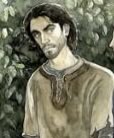Lothlórien by atalante_star
The book version of Lothlórien
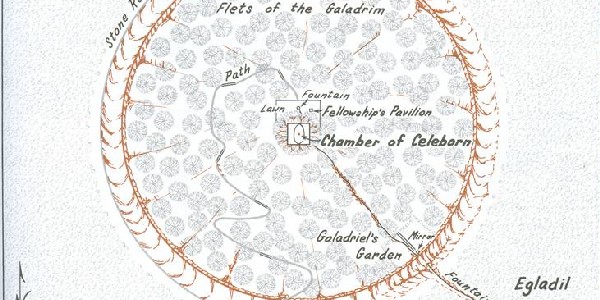
The trees: “That is the fairest of all the dwellings of my people. There are no trees like the trees of that land. For in the autumn their leaves fall not, but turn to gold. Not till the spring comes and the new green opens do they fall, and then the boughs are laden with yellow flowers; and the floor of the wood is golden, and golden is the roof, and its pillars are of silver, for the bark of the trees is smooth and grey.” (Lothlórien)
Mallorns: “The branches of the mallorn-tree grew out nearly straight from the trunk, and then swept upward; but near the top the main stem divided into a crown of many boughs, and among these they found that there had been built a wooden platform, or flet as such things were called in those days: the Elves called it a talan. It was reached by a round hole in the centre through which the ladder passed.” (Lothlórien)
“…its great smooth bole gleamed like grey silk, and up it towered, until its first branches, far above, opened their huge limbs under shadowy clouds of leaves.” (The Mirror of Galadriel)
“Frodo passed many flets: some on some side, some on another, and some set about the bole of the tree, so that the ladder passed through them.” (The Mirror of Galadriel)
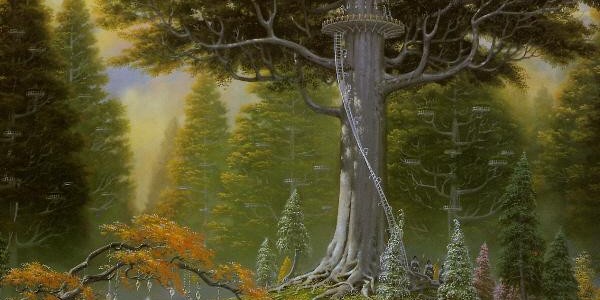
Cerin Amroth: “To the left stood a great mound, covered with a sward of grass as green as Spring-time in the Elder Days. Upon it, as a double crown, grew two circles of trees: the outer had bark of snowy-white, and were leafless but beautiful in their shapely nakedness; the inner were mallorn-trees of great height, still arrayed in pale gold. High amid the branches of a towering tree that stood in the centre of all there gleamed a white flet. At the feet of the trees, and all about the green hillsides the grass was studded with small golden flowers were other flowers, white and palest green: they glimmered as a mist amid the rich hue of the grass. Over all the sky was blue, and the sun of afternoon glowed upon the hill and cast long green shadows beneath the trees.” (Lothlórien)
Caras Galadhon: “There was a wide treeless space before them, running in a great circle and bending away on either hand. Beyond it was a deep fosse lost in soft shadow, but the grass upon its brink was green, as if it glowed still in memory of the sun that had gone. Upon the furthest side there rose to a great height a green wall encircling a green hill thronged with mallorn-trees taller than any they had yet seen in all the land. … In their many-tiered branches and amid their ever-moving leaves countless lights were gleaming, green and gold and silver.” (The Mirror of Galadriel)
There are many details of Caras Galadhon scattered through the Mirror of Galadriel chapter. On the outer edge of the fosse was a road paved with white stone. The great gates of the city faced south-west, and were tall, strong, and hung with many lamps. They were set within a wall that encircled the city, and opened soundlessly with no sign of guards.
Near the top of the hill was a wide lawn with a fountain shimmering in it. The fountain was lit by silver lamps that swung from the trees, and the water spilled into a basin of silver, from which a white stream came forth. On the south side of the lawn was the mightiest of the mallorn trees, upon which was a broad white ladder. At night, a pavilion with soft couches was set up on the lawn for the Fellowship.
At night, the hill looked like it glittered with stars from the lights of the flets.
Celeborn’s Chamber: “he came to a wide talan, like the deck of a great ship. On it was built a house, so large that almost it would have served for a hall of Men upon the earth. … a chamber of oval shape, in the midst of which grew the trunk of the great mallorn, now tapering towards its crown, and yet making still a pillar of wide girth.
The chamber was filled with a soft light; its walls were green and silver and its roof of gold. … On two chairs beneath the bole of the tree and canopied by a living bough there sat, side by side, Celeborn and Galadriel.” (The Mirror of Galadriel)
The Mirror of Galadriel: “she led toward the southern slopes of the hill of Caras Galadhon, and passing through a high green hedge they came into an enclosed garden. No trees grew there, and it lay open to the sky. … Down a long flight of steps the Lady went into a deep green hollow, through which ran murmuring the silver stream that issued from the fountain on the hill. At the bottom, upon a low pedestal carved like a branching tree, stood a basin of silver, wide and shallow, and beside it stood a silver ewer.
The Rivers: “They had gone some ten miles and … Before them lay a long lawn of shining grass, studded with golden elanor that glinted in the sun. The lawn ran out into a narrow tongue between bright margins: on the right and west the Silverlode flowed glittering: on the left and east the Great River rolled its broad waters, deep and dark.” (Farewell to Lórien)
“On the bank of the Silverlode, at some distance up from the meeting of the streams, there was a hythe of white stones and white wood. By it were moored many boats and barges. Some were brightly painted, and shone with silver and gold and green, but most were either white or grey. Three small grey boats had been made ready for the travellers” (Farewell to Lórien)
The Swan Boat: “Its beak shone like burnished gold, and its eyes glinted like jet set in yellow stones; its huge white wings were half lifted. … Two elves clad in white steered it with black paddles.” (Farewell to Lórien)
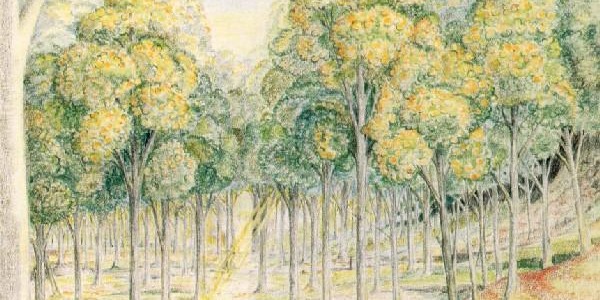
Atmosphere:
“…wolves were howling on the wood’s borders: but on the land of Lórien no shadow lay.” (Lothlórien)
“It seemed to him that he had stepped through a high window that looked on a vanished world. A light was upon it for which his language had no name. All that he saw was shapely, but the shapes seemed at once clear cut, as if they had been first conceived and drawn at the uncovering of his eyes, and ancient as if they had endured for ever. He saw no colour but those he knew, gold and white and blue and green, but they were fresh and poignant, as if he had at that moment first perceived them and made for them names new and wonderful. In winter here no heart could mourn for summer or for spring. No blemish or sickness or deformity could be seen in anything that grew upon the earth. On the land of Lórien there was no stain.” (Lothlórien)
“All the while they dwelt there the sun shone clear, save for a gentle rain that fell at times, and passed away leaving all things fresh and calm. The air was cool and soft, as if it were early spring, yet they felt about them the deep and thoughtful quiet of winter.” (The Mirror of Galadriel)
Lothlórien – the Movie
Lothlórien was one of the more complicated regions of Middle-earth to bring to life. Two miniature sets were built – one of the canopy and one of the ground below. Both were built at 1/14th scale – which still left the trees reaching a height of 12 meters. On the miniatures, over 100 elvish houses were built to populate the branches and over 2,000 individual leaves were hand applied. The flets were created to look like giant mallorn leaves.
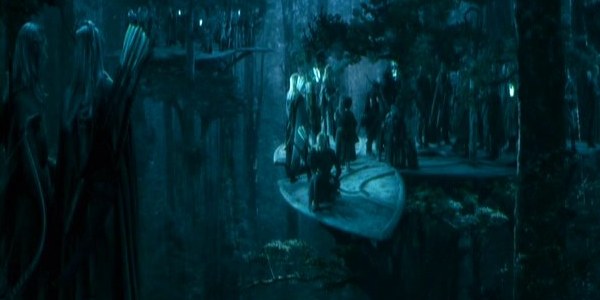
Actors then shot against a blue screen, and were superimposed onto the miniatures.
The set designers wanted Lothlórien to look like a fantasy world – almost an ethereal fairy kingdom set away from the world:
“Lothlórien represents a group of people living in the treetops that have understood the harmony between their construction techniques and the trees that bear the weight of these buildings. Both designs are both inspired by the same aesthetic of nature, organic feelings, growth and the way that nature has a certain randomness in the growth of things.
The world of Lothlórien was envisioned as a beautiful and ethereal Shangri-La and I am very pleased with the final results because it was such a complex miniature to create and the results have certainly paid off.” (Richard Taylor, WETA)
“Lothlórien was like the Swiss Family Robinson treehouse, combined with a grove of sequoias, combined with the Ewok village.” (Paul Lasaigne)
“The interior of Caras Galadhon was a long process, getting the right mixture of organic. In the end the building had a flowerlike appearance” (Alan Lee, Heren Istarion)
While a good number of locations in the Golden Wood are described in the books, only four locations are used in the films:
– the outskirts of the wood where the Fellowship meet Haldir,
– Caras Galadhon (and Celeborn’s chamber),
– Galadriel’s mirror glade, and
– the area around the bridge on the Silverlode.
Where the Fellowship meet Haldir is shown simply as a generic part of the Lórien woodland. Without the background story of Aragorn and Arwen meeting in Lothlórien and Arwen later being laid to rest there, Cerin Amroth loses both the romantic and grief-filled significance that it has in the books. It would be reduced to just another set with little meaning unless Peter Jackson took a good deal of film time to explain its significance. Maybe it is indeed best that the Fellowship just met Haldir in the woods.
The Fellowship is then taken through the woods, seeing a quick glimpse of the city of the Galadhrim from afar, before being taken through to Caras Galadhon and then up to Celeborn’s Chamber.
Note in the picture of Caras Galadhon, there is no sign of the wall, the road, or the gates. In fact, there is no external sign that elves live there, with the city simply looking like a grove of trees.
By the time they arrive at the great mallorn tree in the centre of the city, it was dark. And it is here that the true scale of the mallorns is first realised.
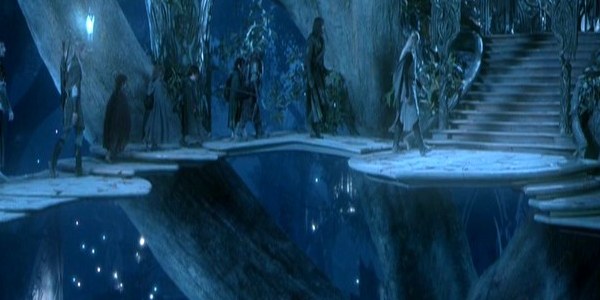

Staircases spiral up the trunks many times before they even reach the first main branches, and they are lit with an eerie blue-white light. When the Fellowship reach the flet which forms the basis of Celeborn’s Chamber, it is easy to compare the size of even small mallorn branches with the size of the people standing in front of them. The film mallorns are truly immense, majestic trees, which is as they should be.
Celeborn’s chamber is completely different in the films from in the books – apart from the fact it is in a mallorn. In the book the talan on which it is based was as large as a Hall of Men – think, for example, Meduseld. The chamber is nowhere near as big as that in the film. In the book it is oval, with the mallorn trunk growing through its middle. In the film, its real shape isn’t possible to make out, but the mallorn trunk does not grow right through it. The chamber also appears to have grown blue-white lit eaves in the film, arching up from each side of the doorway, and it’s decoration is a mix of organic branch-like motifs and more structured Art Nouveau elements. The chamber was also almost exclusively bluey-silvery-white, a light and colour exaggerated even more by the presence of Celeborn and Galadriel. The idea of the mallorns’ green and gold colouring being reflected in the chamber’s light is completely lost.

After talking to the Lord and Lady, the Fellowship are sent back down to the film’s equivalent of the lawn at the base of the great tree. This lawn is not the beautiful, peaceful lawn of the book, which is set with a silver fountain and myriads of lights. Instead it simply a patch of ground at the base of the tree, though there is indeed some sort of a fountain in it. The resting place for the Fellowship is a distinctly lop-sided tent that is set up around the buttress roots of the mallorn.

Soon after the Fellowship settle down in the pavilion, Galadriel walks down over the lawn and down to her glade. Frodo follows her down some steps, which twist around a big tree and then continue through a ‘gateway’ of statues. The glade itself contains the mirror, which is shown as a simple basin on a round stone plinth with tree-based and Celtic style decoration. Whenn Galadriel fills her silver ewer, she does so from a silvery waterfall – presumably the same waterfall as in the books.
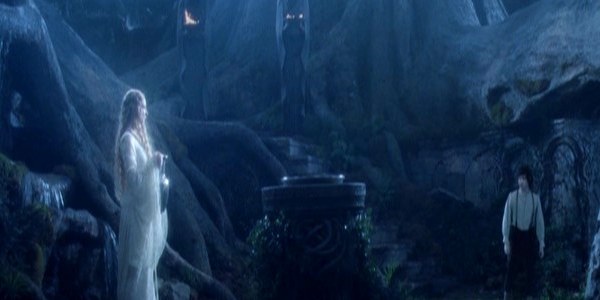
The last Lórien scene in the film is the leaving of the Fellowship. They depart in three grey boats, as per the books, and as they leave, they pass Galadriel’s swan boat. In the background of the scene is a white bridge, the buttress roots of a mallorn, and beyond those, Caras Galadhon.

This set is again very different from the description in the books, and emphasises the mystical, magical nature of Lothlórien rather than its pure natural beauty and tranquillity. The brightly painted boats and barges of the book have gone, as has the lawn studded with yellow flowers of elanor. Also the distance from Caras Galadhon seems somewhat compressed – it is hard to believe that the Silverlode is really ten miles away from the city.
Atmosphere:
Because the Fellowship’s time in Lórien is compressed into only one day and night, there is no sense of the peace and rest they found in the Golden Wood. No sense of the fact that in Lothlórien they had a period of recuperation akin to that which they spent in Rivendell, and thus the similarities between the two elvish realms is diminished. There is no sense of the daytime beauty of the place – the greens and golds of the mallorns, the yellow of the elanor and the white and green of the niphredil. Little sunlight filters through the trees in the film Lórien, while in the books, the light creates dancing shadows on the carpets of grass in the wood.
What is left in the film is a mystical world of shadow and smoke, a realm where an elven queen reigns supreme, a “great sorceress, an elf-witch of terrible power. All who look upon her, fall under her spell…” (Gimli, film FotR, Lothlórien).
While the EE dispels this feeling to some extent, having more footage of the meeting with Haldir, and of Galadriel and Celeborn by the Silverlode – events which both take place in the daylight – the overall feeling still remains one of mystery, of mist-wreathed trees, and elvish magic.
Sequences that play in Lóthlórien:
- Night Over Lothlórien
Characters Connected to Lothlórien:
- Celeborn and Galadriel by atalante_star
- Haldir, Rúmil & Orophin by atalante_star
Interesting Links
See how various artists saw LothlorÃen:
- Lothlórien by Gregory
- The Golden Woods of Lothlórien by Alan Lee
- Lothlórien by Spencer Lee
- The Golden Wood by Sue Porter
- Lothlórien in Summer by the Gubina sisters
- Lothlórien by Micchelucci
- Lothlórien in Spring by Tolkien
- Atop Cerith Amroth by Eissman
- Caras Galadhon by the Brothers Hildebrandt
- The Great Tree of Lórien by Nasmith
- Lothlórien by Rivoche
- Departing Lothlórien by Nasmith
- The Swan Ship of Lórien by Maura Boldi








